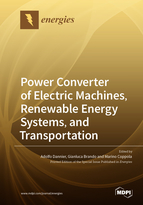Power Converter of Electric Machines, Renewable Energy Systems, and Transportation
A special issue of Energies (ISSN 1996-1073). This special issue belongs to the section "F: Electrical Engineering".
Deadline for manuscript submissions: closed (31 January 2021) | Viewed by 25094
Special Issue Editors
Interests: high-performance dynamic drives with PM motors; power electronic converters; fault tolerance in multilevel converters; power electronic transformer (PET); energy storage for the integration of renewable energy sources and recharge station for electric vehicles
Special Issues, Collections and Topics in MDPI journals
Interests: multilevel diode clamped converters and hybrid-based modulation balancing strategies; multilevel modular converters and harmonic-based balancing strategies; multiphase converters; multiphase electrical pm synchronous machines and inherent MTPA strategies; multiphase induction machines and inherent MTPA strategies; modulation strategies for multilevel modular converters supplied by electrical storage; multimotor/single-inverter electrical drives and inherent MTPA strategies
Special Issues, Collections and Topics in MDPI journals
Interests: design and control of power converters for photovoltaics and distributed power generation systems; integration of renewable energy resources in electrical systems; modulation of multilevel converters; design and control of high efficiency DC–DC converters; design of digital circuits on FPGA
Special Issues, Collections and Topics in MDPI journals
Special Issue Information
Dear Colleagues,
The Guest Editor is inviting submissions to a Special Issue of Energies on the subject area of “Power Converters for Electric Machines, Renewable Energy Systems, and Transportation”. Power converters and electric machines for industrial applications are widely disseminated and tested because they allow high versatility and high efficiency. This know-how represents an excellent starting point, but it cannot be traded in renewable and transport applications, where performance, variable operating conditions, and reliability issues are mandatory constraints. Converter design and control are critical as they are evolving into an essential component to interface and integrate different power systems. Therefore, in this evolution, power converter topology and technology play an enabling role in the advancements of electric machine performance, renewable energy integration, and emerging transport applications. As a consequence, it is necessary to develop innovative systems especially “devoted” to the application under study. This Special Issue serves to address the present challenging issues with design and control techniques for power converters and electric machines. Topics of interest for publication include but are not limited to:
- Power converters for electric machines;
- Power systems for renewable energy resources;
- Drives for transportation;
- Variable speed drives;
- Modeling and design of electric machines;
- Doubly-fed induction generator;
- Energy storage systems;
- Power electronics modulation, control and optimization.
Prof. Dr. Adolfo Dannier
Prof. Dr. Gianluca Brando
Dr. Marino Coppola
Guest Editors
Manuscript Submission Information
Manuscripts should be submitted online at www.mdpi.com by registering and logging in to this website. Once you are registered, click here to go to the submission form. Manuscripts can be submitted until the deadline. All submissions that pass pre-check are peer-reviewed. Accepted papers will be published continuously in the journal (as soon as accepted) and will be listed together on the special issue website. Research articles, review articles as well as short communications are invited. For planned papers, a title and short abstract (about 100 words) can be sent to the Editorial Office for announcement on this website.
Submitted manuscripts should not have been published previously, nor be under consideration for publication elsewhere (except conference proceedings papers). All manuscripts are thoroughly refereed through a single-blind peer-review process. A guide for authors and other relevant information for submission of manuscripts is available on the Instructions for Authors page. Energies is an international peer-reviewed open access semimonthly journal published by MDPI.
Please visit the Instructions for Authors page before submitting a manuscript. The Article Processing Charge (APC) for publication in this open access journal is 2600 CHF (Swiss Francs). Submitted papers should be well formatted and use good English. Authors may use MDPI's English editing service prior to publication or during author revisions.
Keywords
- Power converters
- Electric machines
- Electric drives for transportation
- Power systems for renewable energy
- Power generation
- Energy storage system
- Control of power electronics
- Distributed power generation systems








